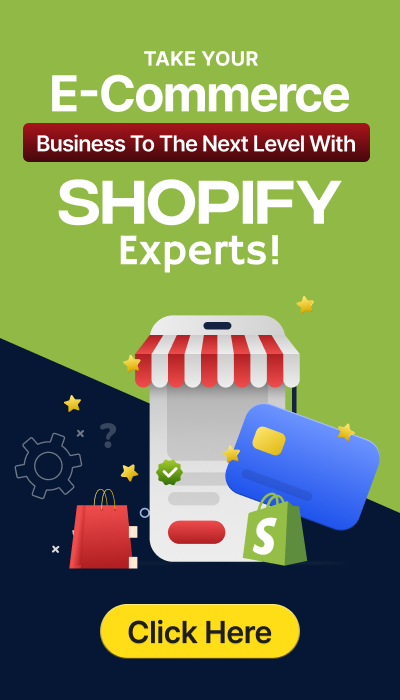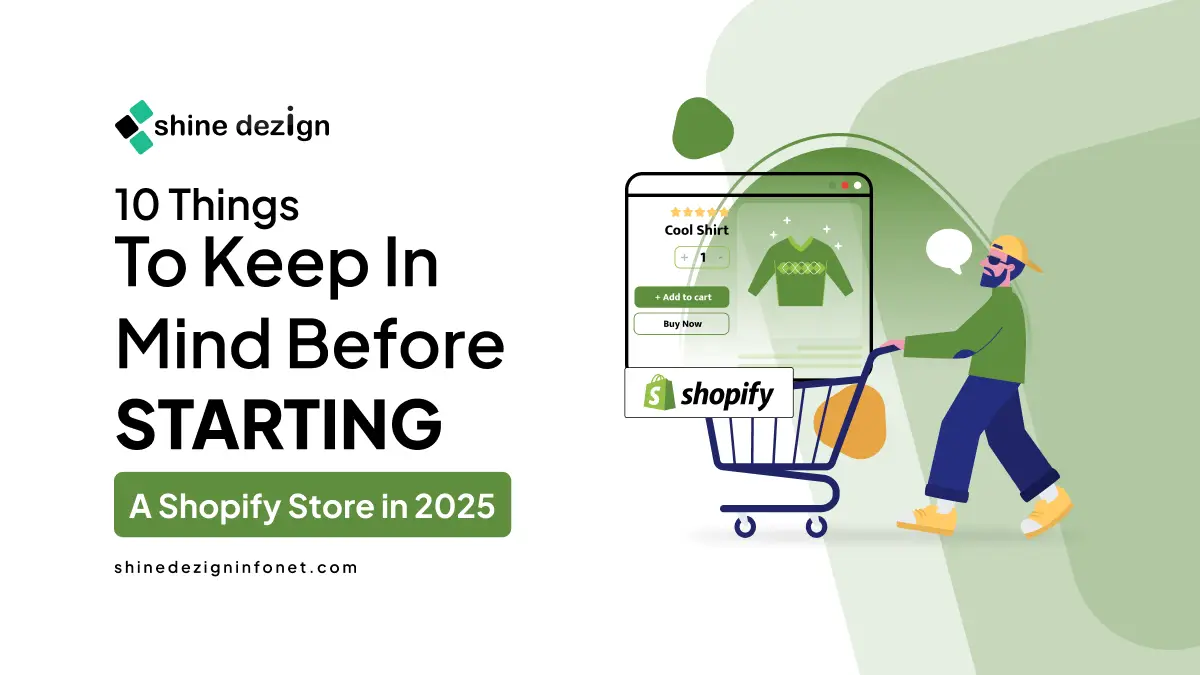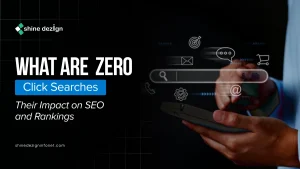Table of Contents
In 2025, the e-commerce landscape is blooming, and Shopify is still one of the most popular platforms for entrepreneurs looking to start a Shopify store and build an online business. However, before you start setting up your store, there are several things to consider ensuring success.
Whether you are an entrepreneur or a first-time seller, being prepared is key to building a sustainable and profitable online business. In this blog, you will learn 10 important things to keep in mind before starting your Shopify store in 2025.
What are the Benefits of Starting a Shopify Store?
 Easy to Use:
Easy to Use:
Shopify is designed to be user-friendly, even for people who don’t have any technical expertise. The platform offers an intuitive interface that allows you to set up your Shopify store quickly & easily.
Entrepreneurs don’t need to know how to code or design websites; Shopify provides a drag-and-drop functionality especially for customization, making it accessible to anyone. Whether you are adding products, setting up payment systems, or creating marketing campaigns, everything is straightforward and easy to navigate.
Scalability:
Shopify is designed to ensure growth with your business. Whether you are just starting a shopify store with a small inventory or managing a large catalogue of products, Shopify can handle it.
As your business expands, you can easily upgrade your plan to access more features and support increased sales volumes. Shopify’s platform supports businesses of all sizes, from small startups to the large- scale enterprises.
Customization:
One of the most significant advantages of starting a Shopify store is the wide variety of customizable themes it offers. You can choose from both free and paid themes that suit your brand. These themes are fully responsive, meaning they will automatically adjust to look great on both desktop & mobile devices.
Shopify also gives you the ability to customize your theme further by editing the HTML/CSS code, by allowing you to create a truly unique shopping experience for your customers.
Excellent Customer Support:
Shopify is known for its excellent customer support. If you run into any issues while setting up your store or managing your business, Shopify offers 24/7 support through multiple channels, including live chat, phone, and email.
Additionally, Shopify has an extensive help center and community forum, where you can find answers to the common questions, troubleshooting tips, and business advice from other entrepreneurs.
Secure and Reliable:
Security is a top priority for any e-commerce business, and Shopify takes this seriously. The platform is PCI DSS compliant, meaning it meets the highest standards for securing customer data.
Shopify also uses SSL encryption to protect sensitive information during transactions, which helps build trust with your customers. Shopify’s hosting service is reliable and offers 99.99% uptime, ensuring that your store is available to customers around the clock without interruptions.
Mobile Friendly:
With an increasing number of consumers shopping on their smartphones and tablets, it’s crucial to have a mobile-optimized store. Shopify ensures that your store is mobile-friendly, providing responsive themes that automatically adjust to different screen sizes.
This mobile optimization helps improve the user experience, leading to higher engagement and increased sales.
Low Startup Cost:
As compared to opening a physical store or developing a custom e-commerce site, starting a Shopify store involves relatively low upfront costs. Shopify offers various pricing plans, starting with a basic plan that is affordable for small businesses and entrepreneurs.
Additionally, since Shopify handles the technical aspects of website hosting and security, you don’t need to invest in expensive web development or IT infrastructure. This makes Shopify an accessible option for anyone looking to start an online business on a budget.
What are the 10 Important Things to Keep in Mind While Building a Shopify Store?
 1. Choosing a Profitable Niche:
1. Choosing a Profitable Niche:
One of the most critical aspects of setting up your Shopify store is the niche you choose. A niche is essentially the specific market or product category you’re focusing on.
Choosing the right niche is the foundation of your business and can make or break your store. In 2025, niches that cater to sustainability, health, and personal well-being, as well as products tailored to digital nomads, remote workers, and tech-savvy consumers, are gaining popularity.
Things to Consider When Selecting a Niche:
- Market demand: Use tools like Google Trends, keyword research tools, and industry reports to see if there is enough interest in your niche.
- Competition: Analyse your competitors. Are there already too many stores selling the same products, or is there room for innovation?
- Profit margins: Consider the cost of goods sold (COGS) and potential markup. Ensure you’re choosing a niche where you can achieve good profit margins.
By selecting the right niche, you can position your store for long-term success, even if you’re just starting out.
2. Research About Your Target Audience
In 2025, consumer preferences are continuously shifting, especially with younger generations like Gen Z and millennials dominating the market. Knowing who you’re selling to is essential. These generations value personalized experiences, ethical brands, and transparency.
Before launching your Shopify store, consider these things:
- Demographics: Age, gender, income level, location, and education are all important factors to understand about your potential customers.
- Psychographics: What are their values, interests, and purchasing behaviours? Are they motivated by price, convenience, sustainability, or uniqueness?
- Buying habits: Are they likely to shop via mobile devices, desktop, or both? Do they make impulse buys or conduct thorough research before purchasing?
The better you understand your target audience, the more effectively you can tailor your product offerings, marketing strategies, and customer service to meet their needs.
3. Creating a Solid Business Plan:
While Shopify makes it easy to create an online store, having a solid business plan is still essential for long-term success. Your business plan doesn’t have to be overly complicated, but it should cover:
- Goals: Define what success looks like for you in both the short and long term.
- Financial projections: Estimate your expected income, expenses, and profit margins.
- Marketing strategy: How will you attract customers to your store? Think about SEO, social media marketing, email campaigns, and influencer partnerships.
- Operations: How will you manage inventory, fulfill orders, handle customer service, and keep your business running smoothly?
Having a clear plan will help you stay focused and motivated as you build and grow your Shopify store.
4. Optimize for Mobile Devices:
As mobile commerce continues to grow in 2025, optimizing your Shopify store for mobile devices is non-negotiable. Most consumers now browse and shop directly from their smartphones or tablets, making mobile optimization critical for maximizing conversions.
Here’s how you can optimize your store for mobile:
- Responsive Design: Ensure your Shopify theme automatically adjusts to different screen sizes and resolutions.
- Mobile-Friendly Navigation: Simplify navigation by reducing the number of clicks needed to find products.
- Fast Loading Speed: Mobile users are often on the go, so slow loading times can lead to lost sales. Make sure your images and pages load quickly by compressing files and minimizing unnecessary scripts.
By creating a seamless mobile shopping experience, you can boost customer satisfaction and increase your sales
5. Designing an Attractive and User-friendly Store:
Your Shopify store’s design plays a massive role in whether customers stay on your site or not. In 2025, users expect a clean, intuitive, and aesthetically pleasing shopping experience. Your website should not only look great but also be easy to navigate and functional.
Here are some key design considerations:
- Use a High-Quality Theme: Shopify offers many free and paid themes that you can customize to fit your brand’s look and feel.
- Product Images: Invest in high-quality images that showcase your products from different angles. Product photos are one of the most important elements influencing buying decisions.
- Clear Calls to Action (CTAs):Use buttons like “Add to Cart,” “Buy Now,” and “Shop More” in prominent positions so visitors know exactly what to do.
By creating an attractive and user-friendly design, you’ll improve your customers’ experience and encourage them to buy from your store.
6. Setting Up Secure Payment Systems:
Security is paramount when it comes to online transactions. In 2025, consumers are more aware of online fraud and data breaches, so offering secure and convenient payment methods is essential. Shopify provides multiple payment options, including credit/debit card payments, PayPal, and Shopify Payments.
Make sure your store:
- Has SSL Encryption: This is crucial for protecting customer data and building trust.
- Offers Multiple Payment Options: Consider offering international payment methods if you plan to sell globally.
- Displays Trust Signals: Use badges like “Secure Checkout” and “Accepted Payment Methods” to reassure customers that their data is safe.
A secure checkout process will help you gain customers’ trust and increase conversions.
7. Leveraging SEO and Content Marketing:
Search engine optimization (SEO) is one of the most effective ways to drive organic traffic to your Shopify store. In 2025, competition is fierce, and ranking high in search engines can give you a competitive edge.
To boost your Shopify SEO:
- Optimize Product Pages: Use relevant keywords in your product descriptions, titles, and metadata.
- Content marketing: Create valuable blog posts, guides, or videos that attract and engage your audience. Content marketing not only boosts SEO but also helps establish your brand as an authority in your niche.
- Link-building: Reach out to influencers or bloggers in your niche to get backlinks to your site, which can improve your domain authority and search rankings.
SEO and content marketing are long-term strategies that can help your store gain visibility and attract consistent traffic.
8. Considering Inventory Management:
Managing inventory is one of the most time-consuming aspects of running an online store. In 2025, you have several options for inventory management, depending on your business model:
- Traditional inventory: You buy and store products, then ship them out when customers place orders.
- Drop shipping: You list products on your store but don’t hold any inventory. When a customer makes a purchase, the supplier ships the product directly to them.
- Print on demand: If you’re selling custom products, you can partner with print-on-demand suppliers who will print and ship items on demand when customers order them.
Choose the inventory model that best suits your business, and make sure you have a solid system in place to track inventory, prevent stockouts, and ensure timely deliveries.
9. Planning for Customer Service:
Providing excellent customer service is essential in 2025, especially as online shoppers have high expectations. Good customer service leads to repeat business, positive reviews, and word-of-mouth referrals.
To provide great customer support:
- Offer Multiple Support Channels: Provide options like live chat, email support, and a comprehensive FAQ section.
- Be Responsive: Respond to inquiries quickly and professionally.
- Handle Complaints Gracefully: If a customer has an issue, address it politely and offer solutions like refunds or exchanges.
Happy customers are more likely to return and recommend your store to others, so investing in excellent customer service is crucial.
10. Monitor and Analyse Performance:
Once your Shopify store is up and running, you need to track its performance to identify areas for improvement. Shopify provides various built-in analytics tools that can give you insights into your store’s traffic, sales, and customer behaviour.
Key performance indicators (KPIs) to track include:
- Conversion Rate: How many visitors are making a purchase?
- Average Order Value (AOV): How much is a customer spending on average?
- Customer Acquisition Cost (CAC): How much are you spending on marketing to acquire a new customer?
By analysing these metrics, you can refine your strategies, optimize your store, and boost your sales.
Summing Up
Starting a Shopify store is an exciting opportunity to boost your business, but it requires careful planning and execution.
By choosing the right niche, understanding your target audience, optimizing for mobile, and creating a seamless user experience, you can set your store up for success. Don’t forget to track your performance and adapt your strategies as needed. With the right preparation, you will be well on your way to building a successful online business.



















